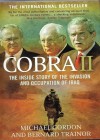Book Review - Cobra II: The Inside Story of the Invasion and Occupation of Iraq
Cobra II: The Inside Story of the Invasion and Occupation of Iraq
Written by: Michael Gordon and Bernard Trainor,
London, Atlantic Books, 2006,
ISBN: 9781843543527, 603pp.
Reviewed by: Colonel R. J. H. Noble, Directing Staff, Australian Command and Staff College
All professional soldiers should read this book. Cobra II is an excellent, well-researched and professionally written account of the planning and conduct of the 2003 invasion of Iraq. It concludes during the early stages of the post-invasion security effort and examines the missed early opportunities and failures that have arguably contributed to the subsequent rise of the insurgency. It achieves the authors’ aim of shedding light on ‘one of the most covered but least understood episodes in recent history’. Perhaps the greatest appeal of the book is the manner in which it links strategic-level issues and decisions through to the real world tactical situations faced by soldiers on the ground. The book, therefore, has something for a wide professional audience. Senior commanders, operational planners, specialists and unit-level soldiers and officers will all take something from this contemporary, easy to read work.
Books by journalists, especially those dealing with contemporary conflicts, are often heavy on emotion and personal opinion but light on genuine research and analysis. This is not such a work. The research is based on detailed interviews and statements from the actual participants. Where possible, it includes the Iraqi side of the story, although access to information and Iraqi personal accounts is limited. Coalition input is also fairly meagre.
One of the authors operated as an embedded journalist and saw some of the events covered first-hand and in real-time. The book is written dispassionately and in the style of a professional, well-referenced, narrative history. One is left largely free to make independent judgements and linkages. Nor do the authors shrink from pointing out weaknesses or errors—usually based on expert comment and sensible analysis. There is no incessant beating of any particular political drums.
Cobra II gives a first class account of what the authors call the ‘accordion’ nature of campaign planning. The authors’ method draws out the real world tensions, arguments and pressures that exist between the strategic, operational and tactical levels. The book cleverly describes how critical strategic issues and imperatives, especially a desire to limit the size of forces deployed, and to avoid perceived post-war Balkans-style nation building ‘errors’, eventually limited and constrained Coalition forces in the early stages of the post-invasion security operation.
It captures the difficulty facing military commanders in dealing with complexity, uncertainty and shifting intent. This description and picture has the ring of truth and fits with my personal recollection of the environment I observed at first hand in Headquarters CENTCOM during late 2001. While highlighting the critical role of operational commanders, the work indirectly reveals the important role played by key plans staff at the rank of lieutenant colonel and major. For officers in similar jobs today, it is worth reading to reaffirm just how critical this role, and the provision of accurate advice and sharp staff work, remains today. It is a must-read for Staff College students.
A central theme of the book relates to whether the design of the campaign plan for the decisive combat operations contributed to eventual failures and missed opportunities during the subsequent security phase of the operation. Were enough forces deployed? Were realistic and comprehensive preparations for managing post-Saddam Iraq effective? The book raises a number of the critical issues facing modern western forces involved in what General Sir Rupert Smith has recently characterised as ‘war amongst the people’. What is the decisive phase? Should we not begin with the end? What is the utility and limitations of the so-called revolution in military affairs in the battle against urban based, irregular forces? Cobra II provides an excellent, thought-provoking case study in which these critical questions remain a central thread throughout.
When the book turns to Iraq and the execution of the plan, it draws out a whole series of operational and tactical lessons of genuine value to all soldiers. Old lessons are strongly re-affirmed, including the importance of an unrelenting focus on the enemy, the need for synchronised, combined-arms cooperation, and the constant need to be ready for the chaos and violence of battle. There are a series of valuable mini-case studies and discussions such as a close up account of the ill-fated 11th Attack Helicopter Regiment ‘deep attack’ against the Republican Guard located near Kabarla. For those with an interest in offensive support coordination there is an excellent description of the Marine ‘Kill Box’ system and a comparison with conventional US Army fire coordination doctrine.
There is plenty for the manoeuvre soldiers who will be firmly reminded about primacy of close combat, the importance of mission command and the value of protection and firepower. Anyone with doubts about what the Hardened and Networked Army is all about should read the account of the Marine fight for the bridges at Nasariyah or the 2nd BCT assault into central Baghdad. These were not largely fights against conventional forces but rather clashes with committed, well equipped, irregular forces. The authors are determined to remind us that the first American killed was shot by a man in civilian clothes riding in the back of an ordinary truck. Cobra II provides an excellent insight into what combat was like during the 2003 advance, but perhaps more importantly it gives us a warning of the future battles, adversaries and tactics we will face.
Perhaps the final and unintended value of the book is that it starkly reveals the access, power and reach of the modern media. These journalists were granted significant access to multiple levels of command, top to bottom. Their work reflects this comprehensive access. It should make us all think hard about the place and role of media in modern conflict. I urge readers to carefully examine the acknowledgements at the close of the book. It leads to a possible conclusion that those who offered the best access got the best coverage of their points of view. It is certainly something to think about in this time of instant communication and a pervasive press presence.
In summary, this is an outstanding, contemporary professional read. I agree with the authors’ claim that it covers hubris, heroism, high-technology wizardry, cultural ignorance, foreign policy strategy, generalship and fighting. It is daunting in size—603 pages in all—but do not be put off, it is worth the effort.




